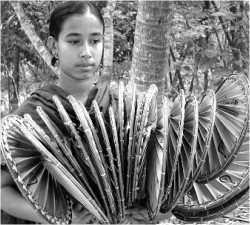| Journey through Bangladesh
From Bogra
Talpakhar Gram
Selina Sheuly
 Hand-fans are ubiquitous fixtures in the lives of many around Bangladesh. We see hand-fans being sold at open-air markets and street shops across town, but hardly anyone knows where they come from. Almost everyone is unaware to its heritage of hand-fan production in this country, one which stretches back a hundred and fifty years. Hand-fans are ubiquitous fixtures in the lives of many around Bangladesh. We see hand-fans being sold at open-air markets and street shops across town, but hardly anyone knows where they come from. Almost everyone is unaware to its heritage of hand-fan production in this country, one which stretches back a hundred and fifty years.
In a remote corner of Bogra's Kahalu upazila, there are two villages known as 'Talpakhar gram', where about two hundred families are engaged in producing hand-fans made of 'tal' leaves the whole year round. About 12 kilometers away from Bogra town, these villages have earned their names from their source of livelihood. The two villages used to be called 'Kahalur Jogir Bhobon Gram' and 'Arola'. This area used to be famous for 'Bolkainath Goswami's Zaminder House'. Sages used to frequent the area and some even started living here. The zaminder allotted a place for them to stay, which became known as 'Jogir Bhaban'. Local inhabitants said that fairs would be arranged surrounding this place, and the main attractions of the fair were the different types of hand-fans. These villages have been producing hand-fans for about three generations, since the time of Zaminder Bolkainath.
An adult villager produces about 30 hand-fans everyday on average, depending on the type of hand-fans being made. Although produced with the same leaves, four different kinds of hand-fans can be made. They are (i) 'Data pakha' (fans with handles sold at Tk. 800 to 1000 per hundred fans), (ii) 'Horton pakha' (fans without handles sold at Tk. 350 to 400 per hundred fans), (iii) 'Ghurki' (fans that can be swung 360 degrees round and round sold at Tk. 800 to 850 per hundred fans) and (iv) 'Pocket pakha' (fans that can be folded, made smaller and kept in a pocket sold at Tk. 300 per hundred fans).
According to veteran fan-maker Abdus Sobhan (65), villagers of the area need no special training to be able to make hand-fans. Between learning to help out with small chores and the actual production procedure, people here learn the trade from a young age. He reckons that they used to be able to gather enough raw materials ('Tal' leaves) from around their own village. But now that local resources have been depleted, they have to bring raw materials from Rajshahi and Naogaon. There are three large sources at the moment: Patnitola and Mohadebpur in Naogaon and Ghupshi in Rajshahi. According to Siddique Hossain, another hand-fan maker, a hundred 'Tal' leaves cost Tk. 300 to 350. With handling and transportation costs, it amounts to Tk. 600 per hundred leaves. The average cost of production per unit of hand-fan is estimated at Tk. 6 to 7 for the large ones and Tk. 2.5 to 4 for the smaller ones.
As can be expected, the demand for such fans is the highest during the summer season, although the overall demand has fallen due to greater coverage of the national grid electricity and solar-power generating units. Hand-fans are sold by wholesalers in Sirajganj, Sohagpur, Tangail and Kushtia. Realizing that the fans can be produced at a cheaper cost if leaves were available close-by, many have sown 'Tal' plants on roadsides of the village.
Due to the lack of credit or finance, many producers have to take loans from their wholesalers prior to peak-production seasons, and, as a result, do not receive a decent price. There is absolutely zero government assistance or provision of easy finance in this trade. Perhaps this is one of the many sectors where microfinance or non-government financial credit mechanisms can find ways to work wonders.
Translated by Zahidul Naim Zakaria
|

